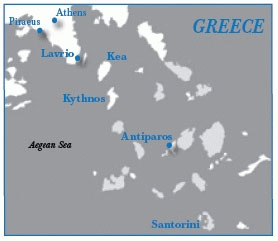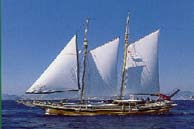Aegean Islands, GreeceContents of this Issue: Castle Comfort Lodge, Dominica Will Katie PriceŐs Breast Implants Explode Underwater? California Legislature Declares Diving ŇHazardousÓ Researchers Face Criminal Charges for Giving Sheep the Bends The Risks of Oxygen at Increased Depth The Unprofessional Side of Placing Blame Finding Diver-Friendly Life Insurance Jacques Cousteau: The Sea King Editorial Office: Ben Davison Publisher and Editor Undercurrent 3020 Bridgeway, Suite 102 Sausalito, CA 94965 itŐs the wrecks and wine jugs, not the reefs from the September, 2010 issue of Undercurrent
Before I left home, Ben Davison cautioned me that there weren’t any reefs left in Greece’s Aegean Sea, and certainly no significant fish life. He was right. But that’s not why I ventured there. Greek diving is about wrecks both ancient and modern, fragments of ancient amphorae (wine or oil jugs) and unusual volcanic topography including caverns, swim-throughs and chimneys. And there are dive operations everywhere -- 180, according to one divemaster. Through the World of Diving website (www.worldofdiving.com), I booked the Margarita, a 65-foot power sailboat billed as a 10-passenger “luxury yacht” and owned by Tim Monsul in New Jersey. Although $1,990 for five nights was steep, the prospect of diving Greek islands in luxury was too tempting. The double cabin had a private shower and toilet, and we would dive different islands from the boat for four days, have breakfast and a lunch basket, use their dive gear (there is little room on the Margarita to rinse, dry and transport one’s own equipment) with wetsuits for rent. Moreover, we’d get one night in a hotel before departure, then four nights in Santorini to dive at our own expense. After I made final payment, Tim informed me that Greek diving laws had changed and we must use local operators. We could cancel, but otherwise the price remained the same and we would have to walk or get picked up by a local dive shop on each island for the diving. My buddy and I decided to stick it out, joining a 60-ish couple from the Midwest, an experienced female diver and novice male diver. Once on board, I discovered that two-person cabins were barely big enough for one person, and not standing up. (I’m used to dive boats, and this is not one of them.) When we realized there were five empty cabins, we asked the Captain if we could each have our own cabin. Had he not said yes, I might have jumped ship. Tim’s choice of dive operators in Lavrio, Antiparos and Kythnos was spot-on professional.
On our first dive day, in Lavrio, near the tip of mainland Greece, Planet
Blue Divers set the tone with a large, modern facility; PADI, NAUI, SSI and technical
diving; and a one-person recompression chamber on the premises. Equipment was included,
and we were offered Nitrox and 5mm wetsuits for the low 70s water at no extra cost. Its
covered motorboat included two divemasters. Owner Kostas Thractides briefed us before
we descended to the Apolonia 6, a cargo ferry at the 80-foot bottom bay, 25 minutes from Lavri, “The ship went down 26 years ago
when the captain either was drunk or fell
asleep.” Then aboard the Margarita to Kea, the first of three Cycladean islands we’d visit. The following morning, we met Kostas, who had motored 90 minutes from Lavrio. The first dive was Patris, an 1882 wreck off of Koundouros Reef upon which it had crashed and landed on its side in two pieces at the 132-foot bottom. As the previous day, the only fish were wrasses and damselfish. After a long, chatty surface interval on Margarita, we dived Koundouros Reef. Same fish, colder water. Aqua Team in Kythnos and Blue Island Divers in Antiparos maintained the standard but without the technical diving, Nitrox or recompression chamber. All dives were conducted after precise briefings in excellent English. At Hagios Sarantis, off of Kythnos, the big draw is ancient amphorae, the clay oil and wine jugs centuries old, some perhaps dating from pre-BC times. Piles of broken shards in the white sand may be of great interest to an historical buff, perhaps a bore to others. A moray hid near one, and the usual wrasses and damsels schooled around. After an hour-long surface interval on Aqua Team’s dive boat, our second dive on Lone Reef began in six-foot swells. Very cold water and nothing to see except a cuttlefish. At a quiet cove in Antiparos with Blue Island Divers, I descended to Bubble Reef. With my hands tucked away from red and yellow fire coral, I kicked over mini-canyons, boulders and the ubiquitous Neptune grass and mermaid’s cups. Two-banded bream swam next to my buddy while he examined a sea mouse shell. I focused on a black and cream nudibranch on a sponge. I reveled in the peacock worms, slipper lobsters, rainbow wrasses, ornate wrasses, red sea stars and morays mouthing from nearly every big rock. In a small cave, schools of orange anthias and cardinalfish stared into my light. Blue Island Dovers owner Gary Gainesbury led us through volcanic chambers and chimney swimthroughs. While spiraling through one, I came nose-to-nose with a red hermit crab. At Santorini, using Aegean Divers, I was excited to dive the massive caldera below Akrotiri, the famous ancient city destroyed by an earthquake in approximately 2,000 BC, as related by my Hungarian divemaster Zoli. My 44-minute dive reached 114 feet with over 1,000 feet more below me, much of it visible in the 90-foot visibility.
I gaped at giant dolmens covered with sponges and algae and the occasional lavender nudibranch. The only fish, however, were damsels and wrasses at 27 feet and a dozen barracuda at 45 feet. Aegean Divers’ boat, Crazy Dreams, was large and shady, stocked with plenty of water, sodas and chocolate croissants for dive intervals. Three divemasters shepherded 11 ability-grouped divers and snorkelers. Four dives cost $185. Margarita captain Vasili and deck hand
Kostas capably handled the boat, and went out of their way to meet our needs and fulfill
our requests. As for meals, I was
disappointed. I expected that breakfast
and lunch would be offered, but
only groceries were provided and we were
expected to do our own cooking. Instead,
every morning, I hopped off the boat and
bought fresh bread loaves from the baker
for our breakfast and lunch for less
than $5, augmented by the boat’s fruit,
peanut butter and jam. Dinners onshore,
however, proved a great way to enjoy
each island and averaged $15 apiece.
With one serious exception, though. The
Midwestern couple ordered lobster and
spaghetti, not on the menu but available
by the kilo, and according to the waiter,
it was one kilo minimum. No price
was requested or quoted. The large lobster
arrived whole and draped over enough spaghetti to feed an army. Diving in June is good in that frequently we were the only divers. High season is July and August, when all of Europe goes on vacation and when the water temps are in the mid- to high 70s. However, locals told me the best conditions are in September, when the water is still warm and the tourists have gone. But, as you can tell from my experience, it’s a rare diver who will walk away satisfied with Greek diving. Unless you have particular interest in diving the Cradle of Western Civilization, you should enjoy a tank or two at the most if you’re here touring the splendors of this ancient land. -- M.S.
|

I want to get all the stories! Tell me how I can become an Undercurrent Online Member and get online access to all the articles of Undercurrent as well as thousands of first hand reports on dive operations world-wide
| Home | Online Members Area | My Account |
Login
|
Join
|
| Travel Index |
Dive Resort & Liveaboard Reviews
|
Featured Reports
|
Recent
Issues
|
Back Issues
|
|
Dive Gear
Index
|
Health/Safety Index
|
Environment & Misc.
Index
|
Seasonal Planner
|
Blogs
|
Free Articles
|
Book Picks
|
News
|
|
Special Offers
|
RSS
|
FAQ
|
About Us
|
Contact Us
|
Links
|
3020 Bridgeway, Ste 102, Sausalito, Ca 94965
All rights reserved.

 Small wrasses and scissortail damsels
flitted around black sponges, the only
evidence of life on the rusting wreck. On
27-percent Nitrox, I explored the outside
and the large propeller for nearly an hour.
During our surface interval, we returned
to the dive center for refreshments, then
motored for 10 minutes to Macronisos Island.
Except for the wreck, it was nearly an identical
dive -- same 80-foot visibility, and
same fish and black sponges but with the
addition of small pink fluffy sponges.
Small wrasses and scissortail damsels
flitted around black sponges, the only
evidence of life on the rusting wreck. On
27-percent Nitrox, I explored the outside
and the large propeller for nearly an hour.
During our surface interval, we returned
to the dive center for refreshments, then
motored for 10 minutes to Macronisos Island.
Except for the wreck, it was nearly an identical
dive -- same 80-foot visibility, and
same fish and black sponges but with the
addition of small pink fluffy sponges.
 The bill: a shocking
US$100. After the trip, Tim Monsul called not only me but my dive buddy and the
other couple to get feedback on improving future dive trips on the Margarita. From a
consumer standpoint, I found that noteworthy.
The bill: a shocking
US$100. After the trip, Tim Monsul called not only me but my dive buddy and the
other couple to get feedback on improving future dive trips on the Margarita. From a
consumer standpoint, I found that noteworthy. Diver’s Compass: The two hotels Tim booked for me worked well for
location and amenities . . . In Piraeus, the Hotel Avra (about $100
a night) was a two-minute walk from the train station, and provided a
full breakfast, but the room stank like a ashtray . . . Hotel Drossos
in Santorini (
Diver’s Compass: The two hotels Tim booked for me worked well for
location and amenities . . . In Piraeus, the Hotel Avra (about $100
a night) was a two-minute walk from the train station, and provided a
full breakfast, but the room stank like a ashtray . . . Hotel Drossos
in Santorini (